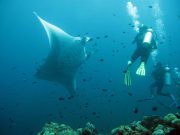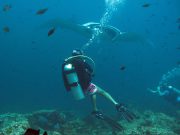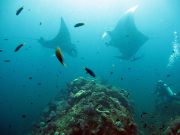Dykning med Mobular stråler
Koh Lantas Marineliv | Mobulidae
Mobular-rokkerne, manta-rokkerne og djævlefiskene er en lille familie af rokker, som mest består af store arter, der lever i det åbne hav i stedet for på havbunden.
Der er 11 arter i denne familie, hvoraf vi nogle gange kan se 1 bestemt medlem, når vi dykker fra Koh Lanta.
Mobular-rokker, manta-rokker og djævlefisk er store pelagiske rokker, der lever af at filtrere føde, med en stor bred skive og 5 gællespalter på undersiden. De har store brystfinner og pisklignende haler med en lille rygfinne. Brystfinnerne strækker sig fremad og danner »horn« foran hovedet, som kaldes kefalfinner. Disse finner kan krummes ud for at skovle føde ind i den brede mund. De cephale finner ligner djævlehorn, og rokkerne i denne familie kaldes nogle gange djævlerokker.
Mobulidae består i øjeblikket af to slægter, Manta og Mobula. Slægten Manta omfatter to arter (Reef Manta & Giant Oceanic Manta), og der er i øjeblikket ni anerkendte arter i slægten Mobula.
1 arter fundet på denne side:
Giant Oceanic Manta Ray
(Manta birostris)
Mantas are the largest of the Ray Family, reaching up to 8m from wing tip to wing tip! If we are lucky the Manta Birostris or Giant Manta, can be seen out on Hin Daeng and Hin Muang.
Rays along with Sharks are an Elasmobranch and have skeletons made up entirely of cartilage. The genus Manta is part of the Eagle Ray family, where it is grouped with Mobula Rays (Devil Rays) in the subfamily Mobulinae.

Manta birostris @ Hin Muang
There are two distinct species of Manta: the smaller Manta Alfredi, has a white or pale coloured mouth and tends to be resident in coastal areas. Manta Birostris, which is larger and has a much darker coloured mouth, these migrate across open oceans visiting reef mounts and pinnacles for cleaning, parasite removal and feeding.
Mantas have large pectoral fins, which give them a blanket-like appearance, hence their name Manta meaning "cloak" in Spanish. These large pectoral fins are able to propel them through the water, gracefully gliding and even making acrobatic movements.
Mantas are filter feeders and sieve their tiny food from the water. Most Rays have a mouth on the underside of their head, while the Manta have theirs at the front. While feeding, they use a pair of fleshy flaps on each side of its head called the Cephalic fin, to channel plankton into their mouths. These fins are rolled into spirals while not in use. Gill Rakers, finger like projections on the gill arches, strain and capture food. Like most Elasmobranch, they must keep swimming to allow oxygenated water to pass through their five pairs of gill slits.
Like Sharks, the Manta fertilises their eggs internally and gives birth to live young, called pups. The manta has one, sometimes two pups per pregnancy and are independent from birth. They will remain in shallow water for a about a year, before heading further offshore and beginning their migration cycle.
Dykning med Mobular stråler omkring Koh Lanta
Dykning og snorkelture
Hvis du gerne vil have chancen for at se Mobular stråler på en af vores daglige dykkerture i højsæsonen fra Koh Lanta, så send os en e-mail til info@diveandrelax.com.
Deltag i vores speedbådsdykkerture i højsæsonen til nogle af Thailands bedste dykkersteder og nyd små grupper, korte rejsetider med fokus på god personlig service, sikkerhed og sjov.
Er du endnu ikke certificeret dykker? Lær at dykke på Koh Lanta med det 3-dages SSI Open Water Diver-kursus.
Book online og spar 10% på dykkerture og dykkerkurser på Koh Lanta.
Få mere at vide
Indo-Stillehavets havdyrsguider
- Allen, G., Steene, R., Humann, P., DeLoach, N. (2003) Reef Fish Identification, Tropical Pacific. Jacksonville, FL., USA: New World Publications, Inc., ISBN 1-878348-36-1.
- Humann, P., DeLoach, N., (2010) Reef Creature Identification, Tropical Pacific. Jacksonville, FL., USA: New World Publications Inc., ISBN 978-1-878348-44-9
- Debelius, H. (2013) Indian Ocean Reef Guide. Frankfurt, Germany: IKAN - Unterwasserarchiv, ISBN 978-3-939767-52-7.
- Debelius, H. (2004) Nudibranchs and Sea Snails, Indo-Pacific Field Guide. Frankfurt, Germany: IKAN - Unterwasserarchiv, ISBN 3-925919-51-1
- Erhardt, H., Knop, D. (2015) Corals Indo-Pacific Field Guide. Frankfurt, Germany: IKAN - Unterwasserarchiv, ISBN 3-925919-69-4.
- Veron J.E.N., Stafford-Smith M.G., Turak E. and DeVantier L.M. (2016). Corals of the World
Flere referencer om havets dyreliv og yderligere information


